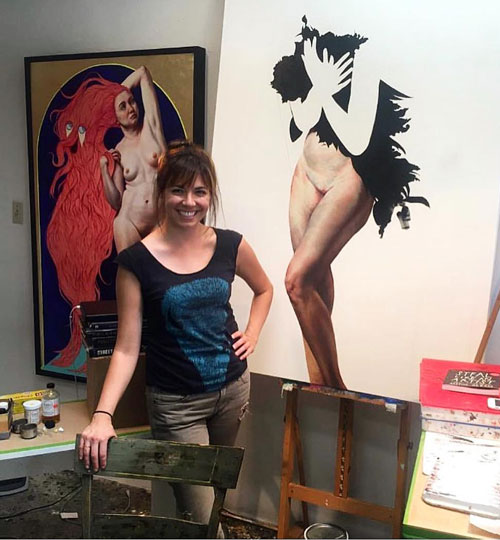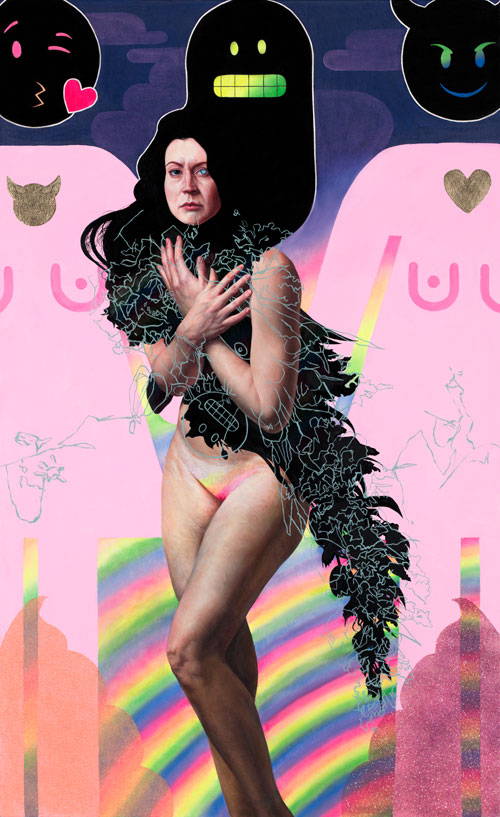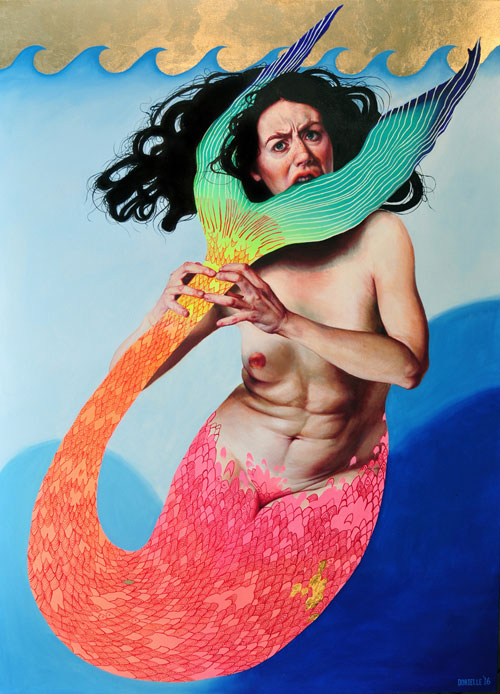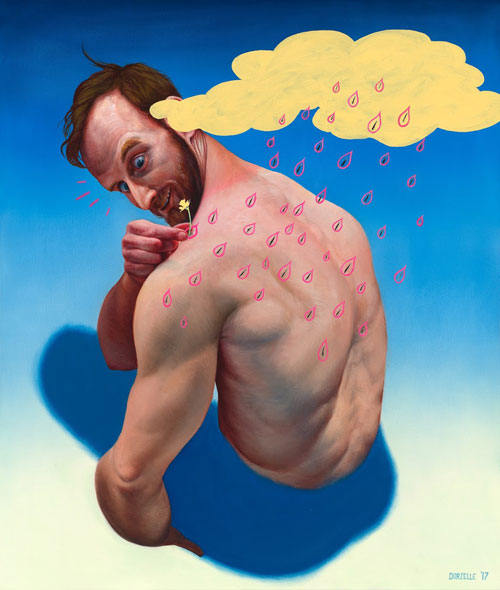Art, // March 30, 2019
Dorielle Caimi — ARTIST
Interview with artist Dorielle Caimi —
Dorielle Caimi
Dorielle is one of ten 2019 The Bennett Prize Finalists. The winner will be announced at the opening exhibition on May 2, 2019 at the Muskegon (Michigan) Museum of Art.
See all ten finalists here: https://thebennettprize.org/finalists-2019
1. Who are you and what do you do?
I am a contemporary painter from New Mexico. I paint people using classical painting techniques but I set them in contemporary, colorful and symbolic settings. I usually tackle difficult and serious subject matter with a sense of humor. The concepts of my work tend to revolve around issues women face in today’s culture.
2. Why art?
I originally wanted to be a comedian, a musician or a writer, but as I grew older, I found that I had a natural aptitude for painting and was able to better express my thoughts through painting.
3. What is your earliest memory of wanting to be an artist?
I remember sitting at a child’s desk in my kitchen when I was about 6. I was working on a series of pen and paper drawings of, basically the same person over and over again, same dress, same puffy sleeves, same single dot for the nose. I remember trying to draw the hand, and it was nearly impossible to figure out. I remember thinking, “maybe if I can figure out how to draw hands, I could be an artist one day.”
4. What are your favorite subject(s) and media(s)?
I only work in oils right now. See question #1 for subject(s).
5. How do you work and approach your subject?
With a full breakfast in my belly and a cup of coffee.
6. What are your favorite art work(s), artist(s)?
To be honest, everyone else’s art is really none of my business because it’s the end result of someone else’s process. I see most art as if it was a shell left behind by a cicada; the life that made it, gone. Also, I find that if I look at too much art, I feel the urge to imitate it, which I don’t like. I like not knowing what the rules are so that I don’t know what’s possible and impossible. That way, I just compare myself to myself and do what I want. I mostly find my inspiration in nature, music, endorphins, funny conversations, political madness, emotions, stains, and dreams.
7. What are the best responses you have had to your work?
A few months ago, a man came into the gallery where I show my work and stood in front of one of my paintings called “GALS” for a long time. He then stepped outside where he “lost it.” He said my painting made him break down and cry. He said he never had an experience like that before and he thanked me. He told me that my work finally hit him about what women have gone through over the centuries.
8. What do you like about your work?
I like that I am able to talk about difficult subjects with my paintings because I use a sense of humor, like using floaties in an uproarious ocean. I seek to push people’s buttons. I like to be irreverent with my work because so much of my life has been rooted in seeking approval: the way I look, how I talk, the way I participate (or not), how sexy I am, how charming I can be, the list is unrelenting and endless. My paintings are the launch pads for not caring about what everyone thinks. In other words, my work gives me freedom and permission to express an authentic self.
9. What advice would you give to other artists?
I will say that being an artist it one of the hardest but most fulfilling things in the world. However, I’ve learned that building a successful art career doesn’t so much hinge on how good you are than it does on how good of a business person you are. Unfortunately, most of us have been taught how to do bad business (if we’ve been taught any business at all). You’ll learn that as an artist, you have got to constantly be fighting for yourself. Art is one of those careers where there is almost zero protection for the artist. So many galleries use artists without paying them and they take at least 50%. People ask you to “pay to play” all the time for exposure. Rejection is a daily thing. And you have to do all this while working your day jobs, often burning the candles at both ends, and trying to make ends meet.
So my best advice to you is this:
Build a solid body of work and only show only the good stuff. Work a little bit every day; just 2-3 hours tops. Be patient; an art career takes time. Do not under any circumstance, go to crazy town and let yourself catastrophize your efforts. Get a good following on social media because you hold the power (not to mention, an audience) when you have followers. The majority of my sales come from my social media following. Make a mailing list. Take good care of your physical and emotional health. Only work with a gallery if they guarantee to sell a piece within 90 days. If they don’t, then drop them. Also, they should buy a piece from you as an investment in good faith when you’re on-boarded. They should also pay 100% of the advertisement fees. They must have connections with legitimate art writers who publish reviews and interviews of your work. Don’t work with people who tell you that you need them because you’re unknown or that you’re not selling because you’re unknown. That’s bullshit. My first gallery right after college took me on (they were also a new gallery) and gave me a solo show. The owner bought a piece and sold another one to a collector. She promoted me to writers at far-reaching, high-profile magazines and publications like Art Forum, Flash Art (UK), Art LTD., and she never had me pay for anything. This is rare, but it does exist and is how it should be. Also, insist on not paying for shipping. That’s a crazy and bizarre practice that we’ve bought into. Think of it this way: you’re essentially a business person creating a product for a gallery (retail). Have you ever found a wholesaler who offers to pay for shipping to their retailer? Umm, H to the no. They should pay for shipping. Not you; not ever. For yourself and on behalf of other artists, you need to start demanding these kind of standards immediately if we are going to change this whole “starving artist” thing.
Remember: when you set your standards of professional treatment of you and your work low, you’re setting them low for everyone. So aim high. Be proud of what you do. Don’t sell yourself short, and follow your gut.
10. Where do you see yourself in 5-10 years?
I see myself as happy happy happy with my life.
LINKS—
Website: dorielle.com
Instagram: @doriellecaimi
Facebook: Dorielle Caimi
Twitter: @doriellecaimi
Artist Bio:
Dorielle Caimi is a Hispanic painter whose family has lived in New Mexico for 15 generations. Her large-scale figurative work highlights the strength and complexity of the female form through a careful and methodical deglamorization of her subjects. In 2010, she completed a BFA in painting (summa cum laude) from Cornish College of the Arts in Seattle, Washington.
Caimi’s work has been shown and featured internationally, and in publications such as PoetsArtists (cover x 2), Beautiful Bizarre Magazine, American Art Collector, Hi-Fructose, Art LTD, Combustus, Juxtapoz and Printer’s Devil Review (cover). In 2015, she was awarded the $10,000 William and Dorothy Yeck Award for work that “visually responds to painting in the 21st century” juried by LACMA’s Franklin Sirmans. Her works have been acquired by Miami University Permanent Art Collection, The Tullman Collection, The Kelsey Lee-Offield Collection and The Art of Elysium Charity Auction. She currently lives, works and teaches in Santa Fe, New Mexico.
Lisa Freeman is an Arts Illustrated’s Correspondent, representing the United Kingdom.
Lisa is also a Public Relations Director for – Quite Great PR & Marketing in Cambridge.











